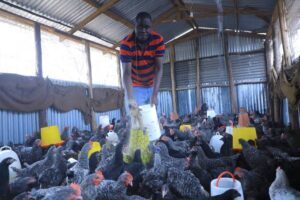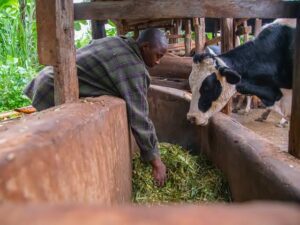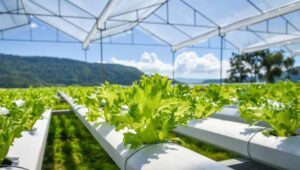Last updated on March 2nd, 2024 at 06:02 pm
Fish farming is a type of aquaculture that involves the controlled production of fish, crustaceans, mollusks, and other aquatic organisms for food or other purposes. Fish farming can be done in different ways, such as using cages, ponds, tanks, or recirculating systems, depending on the available space, resources, and environmental conditions. Fish farming can provide a source of income, food security, and nutrition for people, but it also faces challenges such as environmental impacts, disease outbreaks, and market competition.
Is fish farming profitable in Kenya?
Fish farming is one of the most profitable agribusinesses you can start in Kenya. This is because fish farming requires less capital, especially if you are starting on a small scale. Having a small amount of capital, like 100k, will help set up small fish ponds and buy fingerlings. According to a report shared by Commonwealth Secretariat Dr. George Habib, the fisheries sector also plays a significant role in employment and income generation. During the year 2021, the sector supported a total of 65,000 people directly as fishermen and 70,000 fish farmers with 149,000 stocked fish ponds.
The sector supports about 1.2 million people, directly and indirectly, working as fishermen, traders,
processors, suppliers, and merchants of fishing accessories, as well as employees and their dependents.
Besides being a rich source of protein, especially for riparian communities, the sector is also
important for the preservation of culture, national heritage, and recreational purposes. In 2021, the
Total fish production was 163,702 metric tons worth 30.38 billion Kenya shillings. This was an
8.2% increase in production compared to 151,289 tons worth 26.25 billion Kenya shillings landed
in 2020. The increase in the value was mainly due to the catches from industrial vessels and the
increase in prices for areas with less production based on the demand and supply impacts on the
fish price
Cost of Starting a Fish Farm in Kenya
To start a fish farming business with a capital of 100k in Kenya, here is what you can do, according to my expertise:
- Pond construction: This is the most expensive part of fish farming, as it involves digging, lining, fencing, and plumbing the pond. The cost of pond construction depends on the size, location, and design of the pond. A typical pond size for small-scale fish farming is 300 square meters, which can cost around Ksh40,000.
- Fingerlings: These are young fish that are ready to be stocked in the pond. The choice of fingerlings depends on the type of fish you want to farm, such as tilapia, catfish, or trout. The cost of fingerlings varies depending on the species, size, and quality. A good source of fingerlings is a reputable hatchery or aqua shop. You can expect to pay around Ksh10,000 for 1000 fingerlings.
- Feed: This is the main recurring expense of fish farming, as it affects the growth and health of the fish. The type and amount of feed depend on the species, size, and stage of the fish. You can use commercial feed, farm-made feed, or natural feed. Commercial feed is more convenient and balanced, but also more expensive. Farm-made feed is cheaper and can be made from locally available ingredients, such as maize, soybeans, fishmeal, and oil. Natural feed is the cheapest and can be obtained from the pond environment, such as algae, insects, and worms. You can also use a combination of different feeds to optimize the feed conversion ratio. The cost of feed can range from Ksh20,000 to Ksh40,000 per month, depending on the feed type and quantity.
- Equipment and tools: These are essential for managing and maintaining the pond and the fish. They include nets, buckets, aerators, water pumps, pipes, hoses, thermometers, pH meters, oxygen meters, and weighing scales. The cost of equipment and tools depends on the quality and quantity. You can expect to spend around Sh10,000 for basic equipment and tools.
- Other expenses: These include labor, transportation, electricity, water, taxes, licenses, permits, and marketing. The cost of these expenses depends on the location, size, and scale of the fish farm. You can estimate these expenses to be around Ksh10,000 per month.
Therefore, the total capital required to start fish farming in Kenya in expense is around 100k, with 50k for initial investment and 50k for monthly operating costs. However, this is only a rough estimate and may vary depending on various factors. You should do your own research and consult with experts before starting your fish farming business.
Read Also
Benefits of Fish Farming in Kenya
Kenyan Fish farming comes with a bundle of benefits that are attached to it. Some of these benefits are:
Fishing is a major source of income for many Kenyans. The country’s lakes, rivers, and oceans offer a wide variety of fish. Inland fishing is also popular, with an estimated 2 million people involved in the activity.
The fish farming business is capital intensive and the returns are high. You can make quick profits if you invest in the business. The business also offers you tax breaks which are an added advantage.
The country has a good climate for fish farming; you do not need sophisticated technology to start the business. The fish that you get from the farms are of good quality and can be exported to other countries. Fish farming also provides employment opportunities to many Kenyans.
Read Also
Types of Fish Farming in Kenya
There are three main types of fish farming that are practiced in Kenya:
1. Freshwater fish farming involves raising fish in fresh water bodies such as rivers, dams, and lakes. The most common fish species raised in this type of farming are tilapia and catfish.
2. Marine fish farming is done in salt water areas such as the ocean and seas. The most common fish species raised in this type of farming are tuna, salmon, and sea bass.
3. Brackish water fish farming is done in water that has a mixture of fresh and salt water. This type of farming is mostly done near the coast where there is a mix of fresh and salt water. The most common fish species raised in this type of farming are barramundi and murrel.
Space Needed for Fish Farming in Kenya
Once you understand the cost and benefits of fish farming, it’s time to look at the space requirements. The amount of space needed depends on how many fish you want to raise. If you want to start small, a single pond measuring two acres is enough. However, if you’re looking to expand your business, multiple ponds will be required.
Make sure that the area is close to an ample water source and has enough sunlight for the fish. To maximize profits, construct a pond/tanks close together or in channels that allow for easy water flow between them. If you’re lucky enough to have land with natural streams or rivers then you won’t need any artificial water sources.
The other factor to consider when deciding on how much space you need is whether or not there is enough room for storage and handling of feed as well as equipment such as pumps and filters. Make sure all these elements are included before taking the plunge into fish farming in Kenya.
Read Also
Feeds for Fish
In order for your fish farming business to be successful, you will need to choose the right kind of feed for your fish. There are a variety of feeds available such as industrial feeds, natural feeds, and home-made feeds. It is important to find a feed that is both affordable and provides the necessary nutrients for your fish.
Industrial feed usually consists of dry pellets which are made from soybean meal, corn gluten meal, wheat, dried blood meal or fishmeal. Natural feeds include kitchen leftover foods such as mashed potatoes and vegetables that can be ground into a paste and given to the fish. Lastly, homemade feeds can be made from a combination of grains, legumes and vegetable matter that have been ground into a paste with water.
It is important to remember that not all types of feed are suitable for all types of fish. Different types of fish require different levels of nutrients in their diet so it is important to research which type of feed is best suited for the type of fish being farmed. Additionally, it is necessary to provide your fish with enough food on a daily basis as inadequate supplies can lead to stunted growth and poor health in the long run.
Market & Nutrients for Fish Farming in Kenya
When it comes to fish farming in Kenya, there are two main components you’ll need to keep your eye on—the market and nutrients.
Let’s start with the market. Finding a reliable buyer is key for any business, and it’s no different when it comes to fish farming. Fortunately, there are ample opportunities in Kenya due to the abundance of markets throughout the country. You can easily find buyers at local markets, online through various platforms, or you can join a fish farmers association for support.
As for nutrients, you’ll need to ensure that your fish have access to the right foods so they can grow healthy and strong. Depending on what type of farming you’re doing, the needed ingredients could range from special feeds to natural sources like phytoplankton and zooplankton. And if you’re looking for additional support, talking with a nutritionist or someone experienced in aquaculture can help get your fish farm off on the right foot.
Read Also
Pros and Cons for fish farming in kenya
Fish farming in Kenya has many pros and cons. On the plus side, it is a great way to produce fish that can be sold to restaurants, markets, and grocery stores. Fish farming in Kenya is also relatively inexpensive to start up and maintain, making it attractive to small-scale farmers. Additionally, fish farming is an incredibly sustainable practice that can help reduce overfishing and the pollution of local bodies of water.
Unfortunately, there are some significant issues with fish farming in Kenya. For one thing, it requires a considerable amount of space, which can be hard to come by in densely populated areas.
Furthermore, the proper feed has to be purchased for the fish in order for them to grow properly and quickly – something which can be expensive. Finally, stocking too many fish increases the risk of disease transfer and water contamination from waste.
Challenges and Solutions for fish farming in kenya
When it comes to fish farming in Kenya, you’re likely to face certain challenges. These include poor water quality, disease outbreaks, inadequate feed, and lack of skilled labor.
To tackle these issues, it’s important to invest in knowledge and skills training for farmers. Additionally, proper use of fertilizers, pesticides and other inputs can improve water quality and reduce the incidence of disease.
Good quality feed is essential for better production, so use a balanced diet with sources of proteins like soybean meal or fishmeal. Properly managing water temperatures and stocking densities can reduce disease mortality. Finally, make sure you have access to reliable markets for your fish before investing in a farm.
So, over to you: are you convinced of the benefits of fish farming in Kenya? Have you been inspired to take the plunge into this lucrative and sustainable business? If you have any questions, or need any help getting started, please don’t hesitate to reach out. Until next time, happy fish farming.
Read Also



